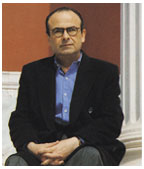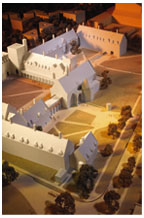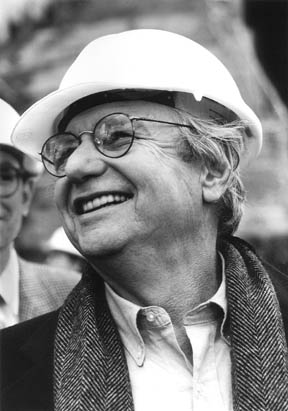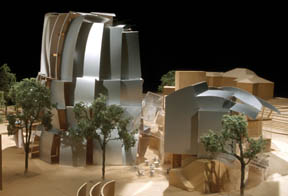December 18, 2002: Features

|
Demetri Porphyrios
*80
Early model
of Whitman College
Frank Gehry
Early model of the science library |
Risk-taking? Tradition-bound?
One campus, different faces
New buildings
have it both ways
By Fred Bernstein ’77
Early in 2004, Princeton will break ground for two of its most ambitious new buildings in decades – Whitman College, a four-year-residential college with room for 500 students, and a new science library adjacent to Fine Tower. Demetri Porphyrios *80 thinks it’s fitting that Whitman, which he designed in the collegiate-gothic style beloved by generations of Princetonians, and the new library, designed by Frank Gehry as a shimmering assemblage of glass and steel, will be constructed simultaneously.
“The two strands in western civilization are the rational and the expressionistic,” Porphyrios explains over lunch in a posh Manhattan restaurant. His own architecture, he says, is rational, based on formulas established in antiquity, while Gehry’s architecture is emotional. “Ask Frank why he designed a building a certain way,” Porphyrios exclaims, “and he’ll say, ‘Because I felt like it.’”
Told of Porphyrios’s comments, Gehry demurs. “I like Demetri very much,” he says. But then he adds of the plans for Whitman College, “It’s funny, that a forward-looking institution would go mucking around in the past. I wouldn’t shout, ‘Don’t do it,’ but it sends the wrong message to the students, to build in a style that was developed for a culture and technology that no longer exist.”
And so Princeton moves full speed ahead – in seemingly opposite directions. It is giving the London-based Porphyrios the biggest U.S. commission of his career, and providing Gehry, widely acclaimed as the world’s most innovative architect, a chance to show how far technology can take him.
In going both routes, is Princeton demonstrating that, as a great university, it is able to embrace competing values? Or is it simply confused? Peter B. Lewis ’55, the auto insurance magnate who is underwriting the new science library, says that as a member of the trustees’ buildings and grounds committee, he embraced the Porphyrios commission. “I applaud both designs,” he says. “Each is right for its location. And the by-play between the two buildings should be very interesting.” But Reed Kroloff, the former editor of Architecture magazine, and now an architecture adviser to a number of cultural institutions, says: “I’m all in favor of diversity, and a certain amount of eclecticism, but the space between Frank Gehry and Demetri Porphyrios is so wide, it’s difficult to understand what Princeton’s intentions are in having them both do major buildings.”
Jon Hlafter ’61 *63, the university’s director of physical planning, has said that as the campus gets bigger, it ought to be divided into neighborhoods, each with its own architectural identity. An academic neighborhood should, in Hlafter’s view, have one style (indeed, different academic neighborhoods might have different styles); a residential neighborhood, another. And what better face for Princeton’s residential neighborhood than collegiate gothic – the mode of every dorm built between 1898 and 1947? If the neighborhood plan is a bit too reminiscent of Disneyland, where Tomorrowland and Main Street U.S.A. coexist a bit uneasily, at least Princeton’s campus developed over time, with distinguished architects of every era adding to the mix.
Elizabeth Plater-Zyberk ’72, dean of the University of Miami School of Architecture and head of the Princeton trustees’ buildings and grounds committee, says the decision to build in the collegiate-gothic style arose out of “a concern that the beloved historic quadrant of the campus was shrinking, relative to the rest of campus.” Today’s undergraduates, she adds, yearn for tradition. Having grown up, in many cases, in suburbia, students are “extremely appreciative of America’s special, old places” – and, apparently, replicas of those places. Collegiate gothic – the style of Oxford and Cambridge – reminds them that they are part of an intellectual tradition, Plater-Zyberk says. “I think there was a concern among the alumni, but also among the students, oddly enough, that we not leave our history behind.” But Plater-Zyberk, best known for designing picturesque “new urbanist” towns that bring diverse architectural styles together, points out that Princeton is building as many modern buildings as at any point in its history. In addition to commissioning Gehry, the university recently unveiled a parking structure by Mexico’s Enrique Norten, in a stripped-down, modernist style, and is about to complete the Lewis-Sigler Institute for Integrative Genomics overlooking Pardee Field. That building, designed by Rafael Viñoly, will have a glass-walled atrium containing a giant metal sculpture by Gehry. And the university just awarded the commission for a new chilled water plant, near Baker Rink, to the Philadelphia firm Leers Weinzapfel – best known for a similar facility, in a shimmering, futuristic glass enclosure, at the University of Pennsylvania.
In addition, Hlafter’s “neighborhood” plan gives donors with very different views on architecture the opportunity to underwrite new buildings. Meg Whitman ’77, the chief executive of eBay, and her husband, Dr. Griffith Harsh, have pledged $30 million for the residential college, which is expected to cost more than $100 million. “While I understand the need for a variety of styles,” she e-mailed, “I’m very much a traditionalist.” Whitman explained that her “fondest memories” of Princeton involve the suites in Blair and Holder Halls, in which she lived for all four years. “Collegiate gothic sets an ambiance for learning that had a very positive impact on me,” she wrote. Porphyrios’s design, she added, is “exactly what I had in mind.”
Lewis, the underwriter of the science library, is a Gehry devotee who famously commissioned the architect to design him a house in Cleveland, a 15-year collaboration that Lewis then abandoned. (Gehry has described Lewis’s periodic payments as “my MacArthur grant,” the no-strings-attached “genius” award.) Earlier this year, the Weatherhead School of Management at Case Western Reserve University moved into the Gehry-designed Peter B. Lewis Building. And Lewis has promised to pay “the last $250 million” if a Gehry-designed Guggenheim Museum is built in lower Manhattan.
As a Princeton trustee, Lewis says, he long supported the idea of a Gehry building on the campus, “but most of the people I talked to weren’t enthusiastic. Then, at his retirement party [former university president] Harold Shapiro *64 came to me and said, ‘We need a science library, we’ve got the right site, and I think I can sell a Gehry building to the university community.’ I told him, ‘If you can sell it, I’ll pay for it.’”
Buildings that brand
Kroloff, the architecture adviser, says that “both Frank and Demetri are enormously talented architects.” But in some quarters, the Porphyrios commission has been derided. “For a distinguished institution that’s concerned with ideas,” hiring Porphyrios “sends absolutely the wrong sort of message,” says William Mitchell, the dean of M.I.T.’s School of Architecture. Mitchell, the architectural adviser to the president of M.I.T., which is now constructing its own Gehry building, asks: “Have you ever seen a gothic air-conditioning unit or a computer network jack? It makes no practical or cultural sense to wrap silly fancy dress around what are, in fact, 21st-century structures housing 21st-century functions.”
In August, Robert Campbell, the architecture critic of the Boston Globe, wrote that Princeton’s plan to build a collegiate-gothic dorm was less about architecture than about “branding.” Campbell, in an article widely circulated through the architecture world by e-mail, wrote that Princeton students, “who grew up wearing shirts that said ‘GAP’ or ‘Abercrombie & Fitch,’ want ‘the right architectural logo.’” The article did not mention the Gehry library.
But it may be that Gehry, now at Case Western and coming soon to M.I.T. and Bard College, where his performing arts center will open this spring, is as much of a brand as is anything Porphryios could dream up – a brand that labels a school forward-thinking, risk-taking, and rich.
Gehry, who grew up in Toronto and took courses at Harvard but never graduated, established his reputation during the 1970s by “exploding” his Southern California house – tearing off siding to expose studs behind corrugated metal and chain link fencing. The library he has designed for Princeton announces its presence with a six-story “tower” covered in cascading sheets of metal, as if communicating with the undulating steel sculpture by Richard Serra already on the site. Two smaller wings, also covered in metal, flank the tower, giving the impression of objects gathered in a landscape rather than a single edifice. The interplay of the three wings creates sheltered areas for outdoor dining that Gehry compares to the courtyards that make the older sections of the Princeton campus so appealing.
The architect is “trying to make the building nothing so much as a good neighbor,” says Craig Webb ’74, Gehry’s project designer. Its six-story core is meant to mediate the height difference between Fine Tower and the residential-scaled buildings of Ivy Lane. The two wings flanking the tower, he adds, “are very similar in scale” to the Robert Stern-designed Center for Jewish Life across the street. “And we’ve selected brick that has a relationship in color to most of the brick on Prospect Street.”
Gehry, who has built more than a dozen models of the building’s various “iterations,” puts it this way: “I’ve spent a lot of time making the building dance with its neighbors.”
While Gehry’s building may be the more striking, visitors to Whitman College also will be surprised by what they find there. “We’re not doing Blair or Little – that’s from another era,” Porphyrios says. “We don’t use history ironically, but we aren’t quoting it verbatim either.” Alumni who remember collegiate-gothic dorms for entryways leading to quirky suites, with fireplaces, window seats, and long treks to the bathroom, may be disappointed. Entryways have been replaced with long wide hallways for better fire safety and accessibility and because hallways are thought to foster social interaction.
Suites are composed largely of single rooms, in part, Porphyrios says, because Meg Whitman believes that “every student should have a place to laugh or cry in private.” Single rooms also will help the university accomplish its goal of attracting juniors, seniors, and even a handful of graduate students to the residential college. In part because many students now grow up in houses where they have their own bedrooms, “the tight little dorm room with a gang bathroom in the basement doesn’t cut it anymore,” says Plater-Zyberk.
Fireplaces have been eliminated as too risky. That means chimneys could be eliminated, too. But Porphryios wants chimneys – “they modulate the skyline,” he says – and he will use them to conceal toilet stacks, which have proliferated with the en suite bathrooms. In making a decision to include chimneys for aesthetic reasons, Porphyrios may be revealing himself to be every bit as “emotional” a designer as Gehry. In Peter Lewis’s view, Porphyrios has to “satisfy people’s memories of collegiate gothic. But every Princeton building, and every person’s memory, is different.” As a result, Lewis concludes, “of the two architects, Porphyrios has the greater challenge.”
Similarities despite differences
Despite the differences between the two projects, Plater-Zyberk says that while hearing the architects’ presentations to the trustees, she “marveled at how many similarities” she could find. Both architects, she says, “take evocative approaches to form. Both styles are very picturesque.” And both are “rooted in tradition. Even Frank acknowledges that he’s in conversation with his predecessors,” she says, referring to the earlier modernists whose rectilinear buildings Gehry’s architecture critiques.
Both buildings have roots in Princeton’s School of Architecture, where Porphyrios and Webb were students in the 1970s – Webb as an undergraduate who would go on to the University of Southern California, Porphyrios as a grad student out of the University of Athens in Greece. Webb remembers that, in that politically charged era, he allied himself with a faction that was designing low-income housing. Porphyrios remembers “fantastic” lectures by the likes of Louis Kahn and Colin Rowe, both of whom were reinterpreting classical orders. His only complaint about Princeton is that, after three years of living an idyllic life in the Graduate College, he married – and was forced to move “to those horrible apartment buildings down by the lake,” he says.
For Porphyrios, that move may have echoed a larger loss. His parents, he says, were thrown out of Constantinople – his preferred name for Istanbul – during anti-Orthodox purges during the 1920s. So growing up in Athens, he says, “life was always about loss, about trying to regain what we’d had.” Then, too, the postwar architecture in Athens was flimsy, utilitarian. At Princeton, Porphyrios not only found an intellectual home – “I learned that architecture could be about ideas” – but in the buildings of the Graduate College, he found the kind of architectural solidity he longed for.
Since then, he has built a practice designing houses for the wealthy – including Jordan’s royal family – and institutional buildings, some of which (like an office building in Birmingham, England, with appliquéd classical details) seem a bit pompous. His most significant public building is a new quadrangle at Magdalen College, Oxford, which simplifies traditional details in a way that makes the building a good neighbor to, but no substitute for, that college’s historic structures.
Both Porphyrios and Gehry design in ways that eliminate economies of scale – the hallmark of most postwar architecture. As a result, both the residential college and the science library are “luxury buildings” few institutions could afford.
In the case of Porphyrios, 2,500 tons of stone – the argillite used in such buildings as Henry and Foulke Halls – must be cut and pieced together into walls as much as 16 inches thick. Gehry’s work is at least as dependent on complex detailing. At M.I.T.’s Stata Center, a computer sciences laboratory now under construction, every inch of the building bears Gehry’s flourishes, meaning there are almost no right angles. Interior spaces are arranged in double-height pods that are more sculptural than office-like. But Stata is being built for $212 million. The construction budget for Princeton’s new building is a mere $37 million. (The total budget is about $60 million.)
According to Webb, construction estimates – received after the trustees gave tentative approval to the building last September – have far exceeded $37 million. “New Jersey is an expensive place to build,” he says. Gehry has increased the amount of brick, relative to metal, and will use stainless steel rather than the titanium that makes his Guggenheim Museum in Bilbao shimmer. Says Gehry, “It isn’t easy, but we’re facing the budget forthrightly.”
Hlafter, who has presided over Princeton’s physical plan since 1968, says the buildings will be finished on time – in 2006 – and within budget. To be safe, he has postponed his retirement, noting that the chance to work with Porphyrios and Gehry was too exciting to pass up.
Hlafter’s last buildings will stand for generations
– and generations of students will debate just what they stand for.
![]()
Fred Bernstein ’77 is a contributing editor at the British magazines Blueprint and World Architecture and writes frequently for the New York Times.
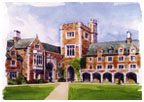 Building
Whitman College
Building
Whitman College
Illustration: Conceptual sketch of an interior courtyard of Whitman College.(porphyrious associates)
Under Demetri Porphyrios’s plan, the walls of Whitman College will be made of argillite, the multihued stone used in such “recent” collegiate-gothic dorms as Henry, Foulke, and Lockhart. Before the university approved Porphyrios’s design, project manager George Olexa visited eastern Pennsylvania, satisfying himself “that there were active argillite quarries, and that they could generate the required 2,500 tons of stone.”
More difficult than obtaining the material is turning it into properly picturesque walls. Before World War II, the university imported stonemasons from Italy; famously, many of Princeton’s Italian families are descended from those masons. But importing labor this time doesn’t make sense for a number of reasons, not the least of which is Princeton’s policy of employing only union workers on the main campus.
Enter the International Union of Bricklayers and Allied Craftworkers, which – aware of a shortage of masons to repair historic buildings, especially in Washington, D.C. – recently opened a training facility in Fort Ritchie, Maryland. During a visit to the facility, Olexa says, union officials guaranteed him that they would train enough people to do the work, which he has estimated at 29,000 person-hours.
Most of the cutting will be done at the quarries. Cut stone will be sorted by size and color and delivered to the site on pallets. Masons on campus would select and position the pieces, and do final “chipping and shaping.” That means the masons, not the architects, will be making aesthetic decisions.
The goal, Olexa says, is to keep the arrangement of stones looking random – “you don’t want them to develop a pattern.” He devised a plan to rotate work crews, fearing that if a group of masons spends too much time on one wall, it will take on a distinctive cast – as he puts it, “too much blue in one place, too much red in another.” He promises to be at the site every day, making sure colors are evenly distributed.
Olexa, a civil engineer, worked for the Port Authority of New York and New Jersey and for Princeton Borough before coming to the university; he has since been involved in the construction of two new dormitories and the renovation of several others, including the current gut rehab of Witherspoon Hall. No issue is too small for the man charged with completing Whitman on time, and on budget. In August, he had two small sample walls built near the site; this fall, the mortar started turning blotchy. “We don’t know if it’s something leaching from the stone,” he says, “or if it’s the water that we used. We’ve taken samples to make sure this doesn’t happen on the building.”
Porphyrios says that using stone will cost $4 million more than if Whitman College had been clad in brick, which he calls a “surprisingly small” price to pay to get the building to resemble its collegiate-gothic neighbors. Still, the resemblance to true gothic buildings will be only skin deep. Although Porphyrios calls the walls load-bearing, they will support only their own weight. (In many modern buildings, masonry panels, supported by steel or concrete beams, don’t do even that.) The building’s true structure, concrete blocks supporting concrete slab floors, will be in place before the first piece of argillite is installed nearly a year into the construction process. For that first year, Whitman will look pretty much like any other new building.
By Fred Bernstein ’77
A library for the future
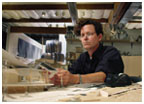 |
| Architect Craig Webb ’74 of Gehry Partners works on a model of the science library being designed for Princeton. (Gehry Partners, LLP) |
When students enter the Frank Gehry-designed science library in 2006, books may be the last thing they see.
If preliminary plans hold, they’ll discover rooms wired for every conceivable audio, visual, and computer device and a training area for learning to use them. The focus will be on digital information, from online journals to extensive databases.
And the books? They’ll be in the basement.
“We’re still talking to people about what they’d like to see, and what they imagine a library needs to look like in 2006,” says University Librarian Karin A. Trainer, who is working closely with project designer Craig Webb ’74 of Gehry Partners.
With science information changing rapidly, a challenge for library planners is how best to outfit the space to accommodate resources yet to be imagined.
“Although we cannot say with precision what information technology will look like five years from now, there are some trends around which we can base our planning,” says Betty Leydon, vice president for information technology. Display screens are growing larger and flatter, calling for rooms with good sightlines and appropriate wall space. Power and networking capabilities are needed throughout. Wireless computing is enhanced by furniture that can be reconfigured so that students can move around.
With the mechanics of teleconferencing becoming more sophisticated, spaces no longer can be static or isolated. As a result, the library will include rooms where the lighting and acoustics are designed specifically for videoconferencing.
And most important, the library’s spaces must not overwhelm those using all these technological wonders, but must enable learning and interaction. “This means that the technology must be integrated into the space design – no cabling strapped to walls, or displays awkwardly hung from ceilings, but rather spaces in which the displays, cameras, microphones, and even computers are fully integrated into the room. For the science library, we have tried to make the information technology planning an integral part of the design, rather than an add-on,” Leydon says.
Reflecting the fluidity of Gehry’s design, the library has been designed to facilitate work that increasingly is interdisciplinary, in chemistry, geosciences, ecology and evolutionary biology, and molecular biology. “We want the building to serve as a crossroads for the science of different disciplines,” Trainer explains.
The traditional library form — stacks of books – will be in a basement level connecting to Fine Hall. The Educational Technologies Center will move to custom-designed space in the library, as will the Princeton Institute for Computational Science and Engineering. A new media center and a mapping center for both traditional paper maps and geospatial data also will be housed there, making the library a focal point for computer-based research.
The social heart of the building, says Webb, will be
its atrium. A café is being considered, and open public areas are
planned to entice visitors to linger as well as study. ![]()
By Maria LoBiondo

